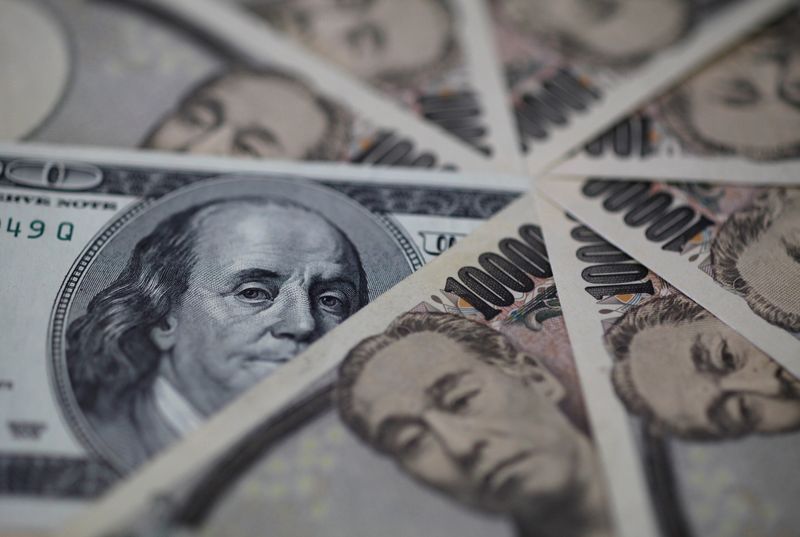What would Japan’s currency intervention to combat a weak yen look like? By Reuters
[ad_1]
 © Reuters. FILE PHOTO: A U.S. hundred dollar bill and Japanese 10,000 yen notes are seen in this photo illustration in Tokyo, February 28, 2013. REUTERS/Shohei Miyano/File Photo
© Reuters. FILE PHOTO: A U.S. hundred dollar bill and Japanese 10,000 yen notes are seen in this photo illustration in Tokyo, February 28, 2013. REUTERS/Shohei Miyano/File PhotoBy Leika Kihara and Tetsushi Kajimoto
TOKYO (Reuters) – Japan’s government and the central bank are “concerned” about recent sharp yen declines and stand ready to respond as needed on currency policy, they said in a rare joint statement on Friday.
“We have seen sharp yen declines and are concerned about recent currency market moves,” the Ministry of Finance, BOJ and the Financial Services Agency said in the joint statement released after their executives’ meeting.
It is rare for officials of the three institutions to issue a joint statement with explicit warnings over currency moves.
The latest jaw-boning came a day after the yen hit a fresh 20-year low against the dollar and a seven-year trough against the euro on expectations the Bank of Japan (BOJ) will continue to lag behind other major central banks in exiting stimulus policy.
The yen is down 15% against the U.S. dollar since early March and hit a 20-yr low of 134.55 this week.
Japanese Finance Minister Shunichi Suzuki on Friday refrained from commenting on the possibility of government intervention in the foreign exchange market to stem the weakness, while maintaining his warning against any rapid fluctuations.
Aside from verbal intervention, Japan has several options to stem excessive yen falls. Among them is to directly intervene in the currency market and buy up large amounts of yen.
Below are details on how yen-buying intervention could work, the likelihood of this happening as well as challenges:
WHEN DID JAPAN LAST CONDUCT YEN-BUYING INTERVENTION?
Given the economy’s heavy reliance on exports, Japan has historically focused on arresting sharp yen rises and taken a hands-off approach on yen falls.
Yen-buying intervention has been very rare. The last time Japan intervened to support its currency was in 1998, when the Asian financial crisis triggered a yen sell-off and a rapid capital outflow from the region. Before that, Tokyo intervened to counter yen falls in 1991-1992.
WHAT WOULD PROMPT TOKYO TO BUY YEN AGAIN?
Currency intervention is costly and could easily fail given the difficulty of influencing its value in the huge global foreign exchange market.
That is one key reason it is considered a last-resort move, which Tokyo would greenlight only when verbal intervention fails to prevent a free fall in the yen. The speed of yen declines, not just levels, would be crucial in authorities’ decision on whether and when to step in.
Some policymakers say intervention would only become an option if Japan faces a “triple” selling of yen, domestic stocks and bonds, in what would be similar to sharp capital outflows experienced in some emerging economies.
HOW WOULD IT WORK?
When Japan intervenes to stem yen rises, the Ministry of Finance issues short-term bills to raise yen which it can then sell in the market to weaken the Japanese currency’s value.
If it were to conduct intervention to stop yen falls, authorities must tap Japan’s foreign reserves for dollars to sell in the market in exchange for yen.
In both cases, the finance minister will issue the final order to intervene. The Bank of Japan will act as an agent and execute the order in the market.
WHAT ARE THE CHALLENGES?
Yen-buying intervention is more difficult than yen-selling.
To conduct dollar-selling, yen-buying intervention, Japan must tap its foreign reserves for dollars it can sell to markets in exchange for yen.
That means there are limits to how long it can keep intervening, unlike for yen-selling intervention – where Tokyo can continue issuing bills to raise yen.
Japan’s foreign reserves stand at $1.33 trillion, the world’s second largest after China’s and likely comprised mostly of dollars. While abundant, reserves could quickly dwindle if huge sums are required to influence rates each time Tokyo steps in.
Currency intervention would also require informal consent by Japan’s G7 counterparts, notably the United States if it were to be conducted against the dollar/yen. That is not easy with Washington traditionally opposed to the idea of currency intervention, except in cases of extreme market volatility.
Source link
